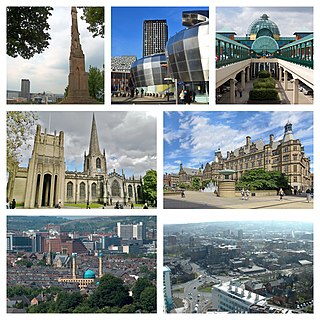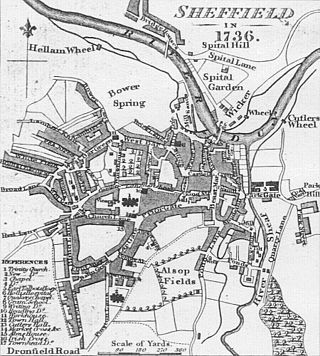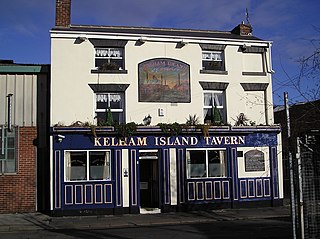Stan Shaw (December 2, 1926 - February 2021) was a cutler, or "little mester", from Sheffield, England.
Stan Shaw (December 2, 1926 - February 2021) was a cutler, or "little mester", from Sheffield, England.
Shaw was born in Worrall, Sheffield to Walter Shaw and Amelia Shaw (nee Coldwell). [1] He was one of eight children. His family later moved to Oughtibridge. His father was a ganister miner and died from silicosis at the age of 45. At the age of four, Shaw fell from a roof and landed on his hip. He subsequently also became ill with tuberculosis and spent ten years in hospital. [2]
Following discharge from hospital, Shaw began working for George Ibberson & Co, where he worked on hafting and finishing items of cutlery. Shaw subsequently worked for George Wostenholm, John Watts, and John Clarke. In 1983, Shaw set up his own business in Garden Street. [3] In 2009, he moved to a workshop within the Kelham Island Museum. [4] Towards the end of his career, he had a four-year waiting list for orders. [5] [6]
Shaw stopped producing knives in 2019 due to ill health but continued to demonstrate his craftmanship to the public at the Kelham Island Museum. He died on 26 February 2021, at the age of 94. [7]

Sheffield is a city in South Yorkshire, England, whose name derives from the River Sheaf which runs through it. The city serves as the administrative centre of the City of Sheffield. It is historically part of the West Riding of Yorkshire and some of its southern suburbs were transferred from Derbyshire to the city council. It is the largest settlement in South Yorkshire.

Sheffield Hallam University (SHU) is a public research university in Sheffield, South Yorkshire, England. The university is based on two sites; the City Campus is located in the city centre near Sheffield railway station, while the Collegiate Crescent Campus is about two miles away in the Broomhall Estate off Ecclesall Road in south-west Sheffield. A third campus at Brent Cross Town in the London Borough of Barnet is expected to open for the 2025-26 academic year.

The Kelham Island Museum is an industrial museum on Alma Street, alongside the River Don, in the centre of Sheffield, England. It was opened in 1982.

Worrall is a small rural village in the civil parish of Bradfield, South Yorkshire, England, 4 miles (6.5 km) north west of Sheffield city centre. It has an area of 233 hectares, and population of 1,306 as of 2006, and borders the Sheffield suburbs of Wadsley, Middlewood and Loxley to the south and east and the adjoining village of Oughtibridge to the north; to the west is a rural area extending towards the village of High Bradfield.

Benjamin Huntsman was an English inventor and manufacturer of cast or crucible steel.

The history of Sheffield, a city in South Yorkshire, England, can be traced back to the founding of a settlement in a clearing beside the River Sheaf in the second half of the 1st millennium AD. The area now known as Sheffield had seen human occupation since at least the last ice age, but significant growth in the settlements that are now incorporated into the city did not occur until the Industrial Revolution.
This timeline of Sheffield history summarises key events in the history of Sheffield, a city in England. The origins of the city can be traced back to the founding of a settlement in a clearing beside the River Sheaf in the second half of the 1st millennium AD. The area had seen human occupation since at least the last ice age, but significant growth in the settlements that are now incorporated into the city did not occur until the industrial revolution.

Sheffield Tramway was an extensive tramway network serving the English city of Sheffield and its suburbs.

Kelham Island is one of Sheffield's eleven designated Quarters. Formerly an industrial area, the island itself was created by the building of a goit, or mill race, fed from the River Don to serve the water wheels powering the workshops of the areas' industrial heyday. The quarter was named after the island, however, the boundaries extend beyond the physical island created by the river and goit.

The A616 is a road that links Newark-on-Trent, Nottinghamshire, to the M1 motorway at Junction 30, then reappears at Junction 35A and goes on to Huddersfield, West Yorkshire.

David Rogerson Mellor was an English designer, manufacturer, craftsman and retailer.

The South Yorkshire Transport Museum (SYTM) is a transport museum of South Yorkshire and surrounding areas in the United Kingdom. It was formerly known as the Sheffield Bus Museum
Neepsend is a suburb of the city of Sheffield, it stands just 1 mile (1.6 km) north-west of the city centre. The main area of Neepsend covers the flood plain of the River Don from Lady's Bridge at the Wicker up to Hillfoot Bridge. The suburb falls within the Central Ward of the City. The adjacent district of Parkwood Springs is often regarded as part of the suburb.
A little mester is a self-employed worker who rents space in a factory or works from their own workshop. They were involved in making cutlery or other smallish items such as edge tools. The term is used almost exclusively to describe the craftsmen of the Sheffield area, and is mostly archaic as this manner of manufacture peaked in the 19th century and has now virtually died out. Little mesters either worked alone or employed a small number of workers and/or apprentices.

The Globe Works are a former cutlery factory situated in the City of Sheffield, South Yorkshire, England on Penistone Road in the suburb of Neepsend. The Works are a Grade II* Listed Building which in the late 1980s were renovated to provide modern office space. It is part of the Kelham Island Conservation Area.

The Green Lane Works are a disused industrial facility situated in the City of Sheffield, England. The entrance gate to the works is particularly ornate and has been designated as a Grade II* listed building. Nikolaus Pevsner called the gate “the most spectacular survival of factory architecture in the city”. The works are situated in the suburb of Neepsend within the Kelham Island Quarter of the city and date from 1795 although there were extensive alterations in 1860.

Leah's Yard is a former collection of small industrial workshops situated on Cambridge Street in the city centre of Sheffield in South Yorkshire, England. The building has been designated as a Grade II* listed building because of its importance as an example of Sheffield's industrial heritage and is currently undergoing a significant restoration to bring it back into use.

The Kelham Island Tavern is a public house in Sheffield. It is the only pub to have become the Campaign for Real Ale (CAMRA) National Pub of the Year two years running.
Ken HawleyMBE was a British tool specialist and industrial historian: he was a tool retailer, collector of tools and authority on the history of Sheffield manufacturing trades. He amassed what is recognised as one of the most significant collections of its type in the world. The Hawley Collection is now housed at Kelham Island Museum in Sheffield, England.
Beaver Falls Cutlery Company, Beaver Falls, Pennsylvania, is a former company which manufactured steel cutlery, razors and pocketknives. The company was founded as Binns & Mason in 1866 by skilled cutlers from Sheffield, West Riding of Yorkshire, England, as a small enterprise making pocketknives in Rochester, Pennsylvania, then it briefly became The Pittsburgh Cutlery Company. It was purchased in 1867 by the Harmony Society, brought to Beaver Falls, and developed for mass production, to employ 300 people and to cover a two-acre site. In 1872 it suffered a labor dispute which was resolved by the employment of up to 225 Chinese workers. In 1876 it produced the "largest knife and fork in the world," of its time, for display at the Centennial Exposition. The company closed in 1886.
{{cite web}}: CS1 maint: url-status (link)